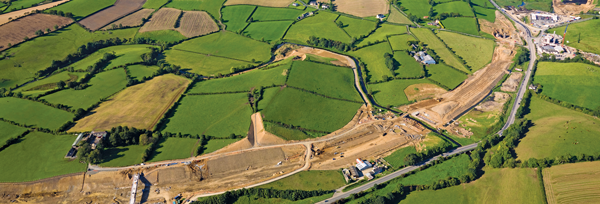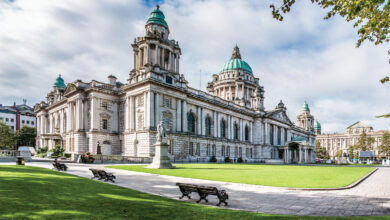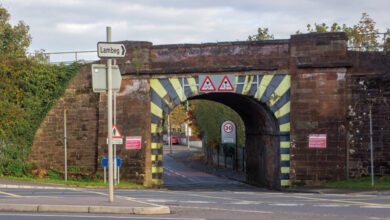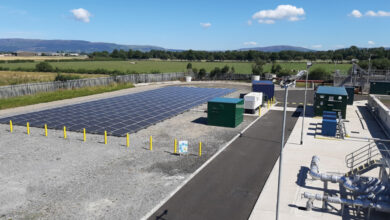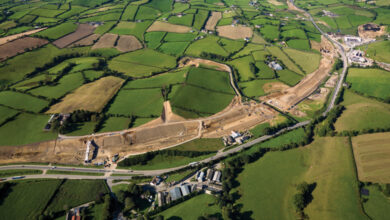Networks
The Executive plans to invest £3 billion into Northern Ireland’s transport, telecoms and energy systems over the next decade. The vast majority of funds (80.4 per cent) are set aside for roads, speeding up journey times but also having a major environmental impact.
| £ million | 2011- 2015 | 2015- 2021 | Total |
| Roads | 1,190 | 1,281 | 2,471 |
| Public transport | 196 | 280 | 476 |
| Telecoms | 14 | 6 | 20 |
| Energy | 10 | 95 | 105 |
| All networks | 1,410 | 1,662 | 3,072 |
Dual carriageways show progress
Key achievements since 2008 have included the improved Westlink route, the dualling of the A1 (Belfast- Dublin), the A4 (Dungannon to Ballygawley) and the A2 near the City of Derry airport, and the completion of work on the A26-M2 Ballee Road East, originally planned to divert traffic round Ballymena in the 1960s.
Smaller works have included the grade separation of four junctions on the A1 and re-aligned upgraded sections of the A4 at Annaghilla and A5 at Tullyvar.
A programme of minor works, including safety improvements and bridge strengthening, has continued as planned, although Roads Service officials also report that funding for this work is now restricted. Indeed, the draft strategy states that motorways and trunk roads will take priority when decisions on structural maintenance are made.
The Cairnshill park-and-ride scheme, outside Belfast, opened in 2010 with 700 spaces. Over 500 buses have been replaced across the network, reducing the fleet’s average age from 12 to seven years.
In rail, the new station at Newry was officially opened in 2009 and includes a 300-space park-and-ride facility. The track life extension between Ballymena and Coleraine was completed in February 2010.
Project Kelvin is, meanwhile, improving the reliability, cost and speed of international data transfer to North America and the rest of Europe, via the link to the submarine cable off the north coast. Eighty-nine per cent of premises in Northern Ireland are now served by a fibre access point: the highest regional coverage in Europe.
A5 dominates the way ahead
The A5 upgrade, one of the largest roads projects in Northern Ireland’s history, is due to go ahead after the public inquiry found in its favour. Local residents, farmers and environmentalists are opposed to the plan and a judicial review case is being prepared. The decision was approved at Executive level by the DUP and Sinn Féin, and implemented by UUP Regional Development Minister Danny Kennedy despite his party’s objections. Friends of the Earth Director James Orr has described it as a “political road” while Peter Robinson and Martin McGuinness see it as an example of Executive delivering for the economy.
Two sections of the A5 will be upgraded to dual carriageways: Derry-Strabane (£170 million) and Omagh- Ballygawley (£160 million). Reductions in funding for the A5 project, due to Irish Government spending cuts, has freed up more money for upgrading the Belfast-Larne A8 (£105 million) and the Belfast-Carrickfergus A2 (£57 million).
Other major works will be taken forward on the Derry- Dungiven A6 and the Westlink’s York Street junction. The first of 20 Class 4000 trains entered service in September 2011, and platforms will be lengthened accordingly.
A consultation on a revised Regional Transportation Strategy took place in spring 2011 and the final version will focus on “moving people rather than moving vehicles”. However, with such a large share of the budget dedicated to roads, no major expansion of rail or other forms of transport is likely.
The recent changes to Belfast city centre’s road layout form part of the preparations for the Belfast Rapid Transit project. Work on the Derry-Coleraine railway line upgrade started in July and the route will be closed for nine months. A full re-lay on the line will be completed by 2021. Potential projects include the new integrated transport hub at Belfast’s Great Victoria Street site and the upgrading of the Knockmore-Lurgan rail line.
Coalition Government funding (£4.4 million) will be invested in broadband development, with additional funding sought for improving access to mobile voice and data services. Significant investment in the electricity grid will be supported although the bulk of the investment will come from private sector sources. The extension of the natural gas network will also be encouraged, “where it is technically possible and economically feasible to do so”.
Missing gateways?
The draft strategy mentions gateways (ports and airports in this instance) as one of the “vital arteries” of a modern economy but no public money is allocated to the sector. £5.6 million was set aside for 2008-2011 but no more was promised. The Regional Development Strategy, though, also refers to Northern Ireland’s land ‘gateways’ i.e. Derry- Letterkenny, Enniskillen-Sligo, Ballygawley-Monaghan and Newry-Dublin, which should benefit from roads investment, especially on the A5 route.

